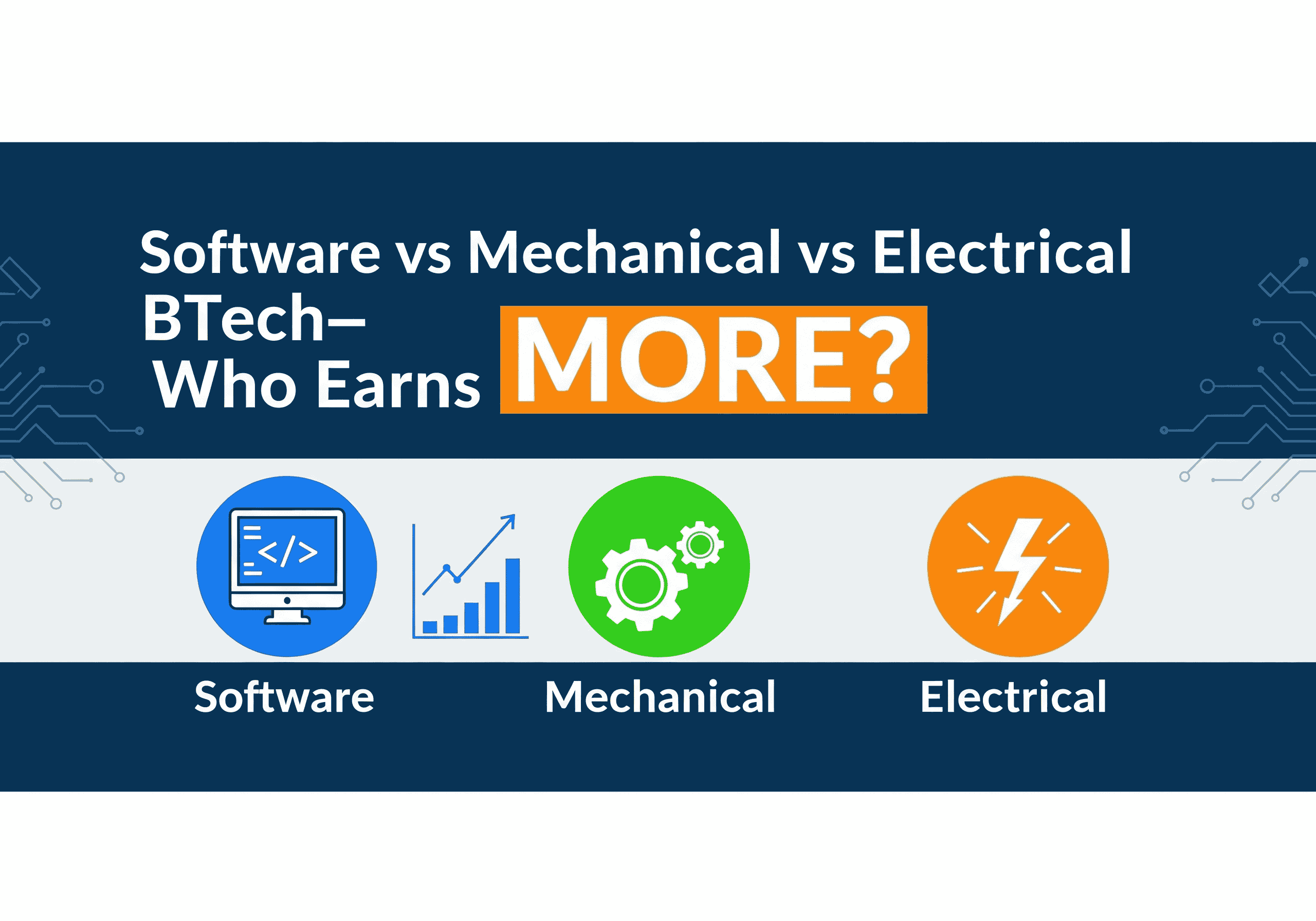
The great debate that resounds in coaching centres, fuels conversations in students’ hostels late at night, and lies at the center of every engineering aspirant’s struggle: You have your entrance exam score, and now you are facing the biggest decision that could affect your career: Which BTech branch should you take?
For many, it all comes down to a single deciding factor: money. As a career strategist, having followed the earning and career paths of thousands of engineers over a period of two decades, I often get asked, “Sir, between Software, Mechanical, and Electrical, who makes more?”
The answer is not as simple as you might think. It’s a story of a sprint versus a marathon. It’s a tale of immediate rewards versus long-term, specialized value. While one branch currently offers the fastest path to a high starting salary, the other two “core” branches hold powerful, often overlooked, secrets to immense long-term wealth.
So, let’s dissect these three foundational branches of engineering, look at the hard data, explore the future trends, and uncover the truth about who earns more in 2025 and beyond.
Chapter 1: The Sprinter – The Software Engineering Path (CSE/IT)
Let’s be direct and address the reality on the ground today. If your primary goal is to get the highest possible starting salary with the largest number of available job opportunities, then Computer Science and Engineering (CSE) and its close cousin, Information Technology (IT), are the undisputed champions.
The Current Reality: Why Software Dominates We live in a world built on code. Every company—from your local bank to a global car manufacturer—is now a technology company at its core. They need websites, mobile apps, cloud infrastructure, and data analytics to survive and compete. This relentless, industry-agnostic demand for software has created a massive, high-stakes bidding war for talented developers, making it a seller’s market for skilled graduates.
The Financial Picture:
- Starting Salary: The numbers for software engineers are impressive and widely publicized. A graduate from a decent college can realistically expect a starting package in the range of ₹7 Lakhs to ₹15 Lakhs per annum. For top talent graduating from premier institutions, these numbers often shoot into the stratosphere, with offers from global giants reaching ₹30 Lakhs to over ₹1 Crore.
- Mid-Career Growth (5-10 years): The growth is rapid. As you move from a Software Development Engineer (SDE) to a Senior SDE, a Tech Lead, or an Engineering Manager, your salary can quickly climb into the ₹30 Lakhs to ₹70 Lakhs per annum bracket.
- The Peak Potential: The ceiling is very high. Roles like Principal Engineer, Software Architect, or Director of Engineering at major product companies often come with compensation packages well over the crore mark.
The Important Caveat: The software world is a treadmill that never stops. The technologies that are in high demand today (a specific JavaScript framework, for example) might become outdated in just three years. This path demands a mindset of constant, relentless learning. The competition is fierce, and your skills have a shorter shelf life. The high reward comes with the high pressure of staying relevant. A solid foundational education is essential, which is why many of today’s universities, such as Ajeenkya DY Patil Pune have designed curricula that heavily emphasize CSE and its new specializations to prepare their learners for the industry.
Chapter 2: The Marathon Runner – The Mechanical Engineering Path
Mechanical Engineering is one of the oldest and broadest engineering disciplines. It’s often called the “evergreen branch” because the world will always need engineers who can design, build, and maintain machines. Traditionally, the starting salaries for Mechanical Engineers have been more modest compared to the software boom. But this is a dangerously outdated view.
The 2025 Reality: The High-Tech Reboot of a Core Branch Today, Mechanical Engineering is undergoing a massive, technology-driven transformation. The “grease and gears” stereotype is being replaced by a world of smart robots, autonomous vehicles, and intelligent manufacturing. A “generic” Mechanical Engineer might still start at a lower salary, but one who specializes in the high-tech domains of the future is now one of the most sought-after and highly-paid professionals.
The New High-Paying Domains:
- Robotics and Automation: This is the heart of Industry 4.0. These engineers design the robots and automated systems that run modern smart factories, from automotive assembly lines to pharmaceutical plants.
- Electric Vehicle (EV) Technology: This is a revolution. Mechanical engineers are critical for designing the battery packs, managing thermal systems, creating lightweight vehicle structures, and perfecting vehicle dynamics for the next generation of EVs.
- 3D Printing & Additive Manufacturing: This field is changing how we design and build everything, from custom medical implants to complex aerospace components.
- Mechatronics: This powerful specialization blends Mechanical engineering with Electronics and Computer Science to create smart, electromechanical systems.
The Financial Picture (with a twist): A Mechanical Engineer with a generic production-focused skillset might start at ₹4 Lakhs to ₹7 Lakhs per annum. However, a graduate with a BTech in Mechanical Engineering who has also mastered Python for automation, learned robotics simulation software, or done projects in EV battery design can command starting salaries of ₹8 Lakhs to ₹14 Lakhs per annum, putting them on par with many software jobs.
The long-term earning potential is immense. Why? Skill Scarcity. There are millions of web developers, but there are very few engineers who deeply understand both vehicle dynamics and battery thermal management. This rarity commands a premium. A top R&D engineer in the EV or aerospace sector can earn well into the ₹50 Lakhs to ₹1 Crore range, and their jobs are often more stable and less susceptible to the rapid boom-and-bust cycles of the software world. To follow this route, students should especially seek to visit universities invested in modern laboratories for robotics, automation, and automotive engineering. Places like Noida International University with its stated focus on engineering and technology in an inter-disciplinary capacity, shows that there is a need for accessibility to that experience.
Chapter 3: The Hidden Powerhouse – The Electrical Engineering Path
Much like Mechanical, Electrical Engineering is another “core” branch that is often misunderstood. Many students associate it primarily with government jobs in power distribution companies. While those stable careers still exist, the modern Electrical Engineer is at the center of the two biggest technological revolutions of our time: the AI & Data revolution and the Green Energy revolution.
The 2025 Reality: Powering the Future, Literally and Figuratively Every single AI server, every smartphone, and every electric car runs on complex electronic components and sophisticated power systems. The Electrical Engineer is the one who designs these.
The New High-Paying Domains:
- VLSI and Semiconductor Design: This is the art and science of designing the microchips that are the “brains” of every electronic device. With the global push for semiconductor self-sufficiency, there is a massive, almost insatiable demand for chip designers in India. This is one of the highest-paying fields in all of engineering.
- Renewable Energy Systems: The world is shifting to solar, wind, and other green energy sources. Electrical engineers are the ones who design, build, and manage these massive power plants and the “smart grids” needed to distribute this energy efficiently.
- Electric Vehicle (EV) Powertrains: This is the heart of an EV. Electrical engineers design the motors, the power electronics, the battery management systems (BMS), and the charging infrastructure that make electric mobility possible.
- IoT and Embedded Systems: This is where Electrical and Computer Science engineering meet. These engineers design the small, smart, connected devices that make up the Internet of Things, from smart home gadgets to industrial sensors.
The Financial Picture (The Top End): A generalist Electrical Engineer might start in the ₹5 Lakhs to ₹8 Lakhs range. However, a specialist’s career looks entirely different. A BTech graduate who enters the VLSI/semiconductor industry can expect starting packages of ₹15 Lakhs to ₹25 Lakhs per annum, often exceeding typical software offers. The demand is so high that companies are willing to pay a massive premium for this talent. Similarly, an expert in power electronics for EVs or smart grid technology is a rare asset whose long-term earning potential is extremely high. Choosing a university with a strong reputation in Electrical and Electronics, like UPES University of petroleum and energy which is building its engineering programs to align with these new industry trends, can be a strategic first step.
Conclusion: So, Who Really Earns More?
Let’s put it all together in a simple verdict.
- For the Highest Starting Salary and Most Job Openings (The Sprint): Software Engineering (CSE/IT) is the clear winner. It offers the fastest, most direct route to a high six-figure income right after graduation.
- For the Highest Potential Long-Term Salary (The Marathon): This is a tie. A Mechanical or Electrical Engineer who becomes a top-tier specialist in a high-demand niche like Robotics, EV Technology, or VLSI Design can absolutely match, and in some cases, even exceed the long-term earnings of a software engineer. Their niche skills are rarer and can command a “scarcity premium.”
The ultimate truth is this: The highest earner is not the Software, Mechanical, or Electrical engineer. The highest earner is the Specialist engineer.
Your branch is your foundation. It’s the language you speak. But your specialization is what makes you a world-renowned poet in that language. Don’t just choose a branch because you heard it pays well. Choose a branch that genuinely interests you, because you can only become a true expert in something you love. Then, identify the most modern, high-growth, technology-driven specialization within that branch and dedicate yourself to mastering it. That is the real formula for earning more.


